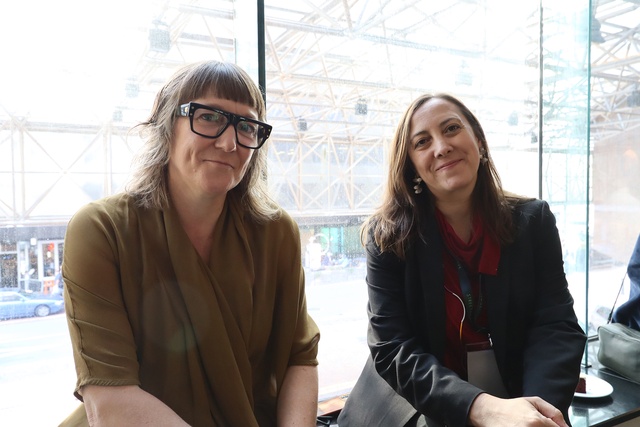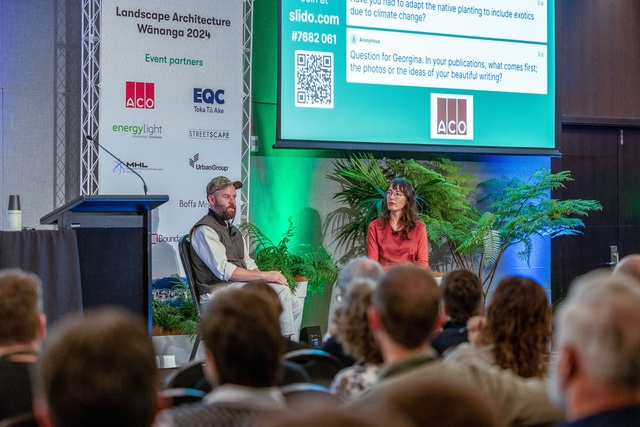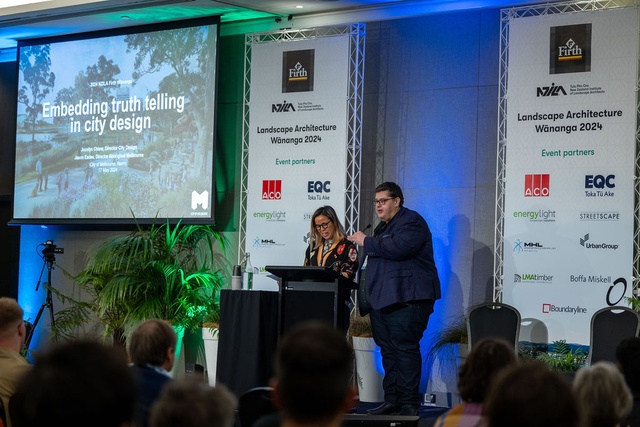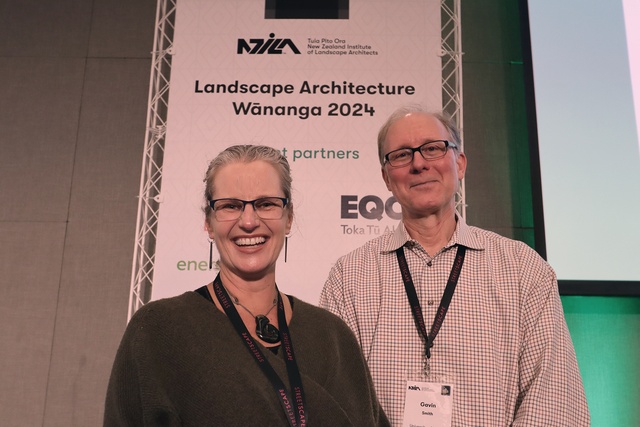The Firth NZILA Wānanga
The Wānanga held by the New Zealand Institute of Landscape Architects Tuia Pito Ora on 16–17 May, was a wellspring of whakaaro, timely perspectives and provocative ideas.
Held in Te Whanganui-a-Tara Wellington the event represented a compelling redesign as the Firth NZILA Tuia Pito Ora Wānanga, with the theme for 2024 māramatanga (enlightenment, insight, understanding).
As observed by opening speaker Dr Alayna Pakinui Rā, the process of a Wānanga denotes a reminder that gatherings like conferences carry with them a responsibility to generate new knowledge and to “challenge what we know and what we think”.
That wero (challenge) was certainly picked up by all of the presenters – from Di Lucas, who marked 50 years in the profession in Aotearoa, through to international guests Marina Cervera of Spain, David Godshall and Gavin Smith of the USA and Australian neighbours Claire Martin, Georgina Reid, Jocelyn Chiew and Jason Eades.
The Wānanga delivered a well-crafted programme that nimbly segued between reflections on landscape practice through to elements of urban and garden design, and ended with the collective responses needed to tackle the challenges of our planet’s climate breakdown.
Claire Martin, a past president of the Australian Institute of Landscape Architects (AILA) and Associate Director of OCULUS, gave a presentation that was a deeply layered exposition of the troubled era we inhabit.

Martin lauded the “relational energy” that landscape architects can generate to reconcile tensions between the built and natural environments as a hidden superpower.
Balancing frustration at squandered opportunities on one hand, with optimism on the other, she presented some practical wayfinding for navigating the future. These pointers included useful urban design guides and toolkits that promote sensitivity to biodiversity and gender needs, as well as the practice of ‘green social prescribing’ and the City of Melbourne’s Green Factor Tool.
Martin’s talk also emphasised the need for better language in bringing landscape architecture to the collective conscious which was later echoed at the NZILA Wānanga in presentations by Haley Hooper, an urban planner and ArchitectureNow contributor, and writer Georgina Reid.
In a talk titled ‘When Worlds Collide’ Hooper referred to unintended consequences that can arise from the language we use and lazy use of throw-away words like “thriving”, stating that “how we define things matters (as does) redefining words where we can”.
Reid, publisher of four limited issues of the print journal Wonderground, introduced the idea of language as an enclosing boundary fence that lacks the permeability we need to make more attuned sense of our lived world. Within that metaphorical fence, Reid posited, exists “all the words” that make up the bureaucratic, all too dead “discourse of neoliberal professional services and human exceptionalism”.
“The stories you as landscape architects can tell about the work you do — work that might be some of the most urgent and important of our times — really matters,” said Reid.

Reid, similarly to Di Lucas, has strong ties to rural land traceable to growing up on a remote farm in New South Wales. She spoke about how there is an “unruly” side to the complex and paradoxical relationships that humans have with land, in both its beautiful aspects and its damaged realities.
She cited Aboriginal philosopher Dr Mary Graham’s view that how we treat the land “determines our human-ness”, adding “just as we work on land, land works on us”.
Califiornian David Godshall (Terremoto) who was described by Reid in 2022, as “Irrepressible. Optimistic. Deeply intelligent. Slightly mad”, gave a presentation that brought attention to the hands-on practice of ‘light touch’ landscaping.
He described how Terremoto’s ‘back lot’ projects bordered on being a form of subterfuge and renegade guerrilla action, marked out by a determination to maximise ecological returns while minimising human and mechanical input.
“We try to eliminate as little existing plant material as possible,” said Godshall. “(On our projects) we ask what does water want? What do the creatures who inhabit this as a habitat want?”
Examples of the positive impact of landscape architecture on the future shaping of major cities emerged from talks by Marina Cervera from a Barcelona perspective, and two leading lights from the City of Melbourne: City Design director Jocelyn Chiew and Aboriginal Melbourne director Jason Eades.
Cervera holds Master’s degrees in both landscape architecture and urban research, a perfect combination for setting out details of the historical journey of Barcelona’s green infrastructure, up to and including work by influential figures such as another recent visitor to New Zealand, Salvador Rueda.
Her talk focused on the Catalonian capital’s mountainous parks, paths and site preparations for celebrating the imminent centenary of the 1929 Barcelona International Expo.

The tag team of Chiew and Eades laid out a roadmap of ways in which Melbourne is being transformed by a long list of architectural design projects — all infused with a truer sense of an Aboriginal understanding of Country than ever before.
Initiatives that were spoken about included work on a Stolen Generations Marker, an Aboriginal map of Naarm/Melbourne and the city’s place and road naming policy.
Eades: “I like to think of us as disruptors who are slowly moving into the driver’s seat”.
The final pair of speakers to take centre stage, turned attention to climate change. First up was Wendy Saunders who has the wonderful job title of Champion of Land Use Planning at EQC Toka Tū Ake — which from 1 July is changing its name to the Natural Hazards Commission or NHC.
Saunders began her address by bravely admitting that awareness of the significant role that landscape architects can play in activity such as recovery planning had been a blindspot for her. She said she would be correcting that to support her work in building a cadre of “recovery stakeholders” who can then help the NHC to identify where to reduce risks before an event happens.

Gavin Smith, a Professor at North Carolina State University, is a long-term associate of Saunders with expertise in coastal resilience and a long career in responding to disasters as major as Hurricane Katrina as well as the mounting tsunami of so-called “nuisance events”.
Professor Smith regaled the NZILA Wānanga audience with unpleasant tales of “hanging out the side of yet another helicopter taking photos of yet another destructive disaster”.
Professor Smith’s on-the-ground case studies of the evolving role of landscape architecture in advancing resilience and equity included Lahaina, Hawaii and the Hurricane Matthew recovery at Princeville in North Carolina.
At the same time as describing the approach to post-disaster response in the United States as an insane routine of “throwing tons of money at it over and over and then building in the same place again with the same risk”, he also presented examples of partial community relocation that we would call ‘managed retreat’.
Those examples included the work being done at North Carolina State University and places like the Gulf Coast Community Design Studio.
For its part, NZILA Tuia Pito Ora has in recent years through its Climate Action Group, radically raised the sights and sense of urgency for its climate action objectives.
A sign of the progress made on this front is that NZILA President and Board Chair, Debbie Tikao, will be speaking at the IFLA 60th World Congress in Istanbul, Turkey in early September about the indigenous-led climate change adaptation programme Te Kori a te Kō, centred on Akaroa Harbour.

This was also the first national event held by NZILA since its transition from an executive committee to a Board structure in August 2023.
Aspects of the 2024 NZILA Wānanga not covered here are the session presented by Alexi Trenouth on the fun and games of creating skateboarding amenities and Sport NZ’s guidelines for local government, a rebellious presentation from public realm artist Mike Hewson, a speedy tour of the latest publications from the office of the Parliamentary Commissioner for the Environment Simon Upton and a panel korero on the Fast-Track Approvals Bill.
The closing evening was all about the presentation of the 2024 Resene NZILA Award Winners. For a showcase dive into the winners of these bi-annual awards see here.
The 2025 Firth NZILA Tuia Pito Ora Wānanga will be held in Heretaunga Hastings.









